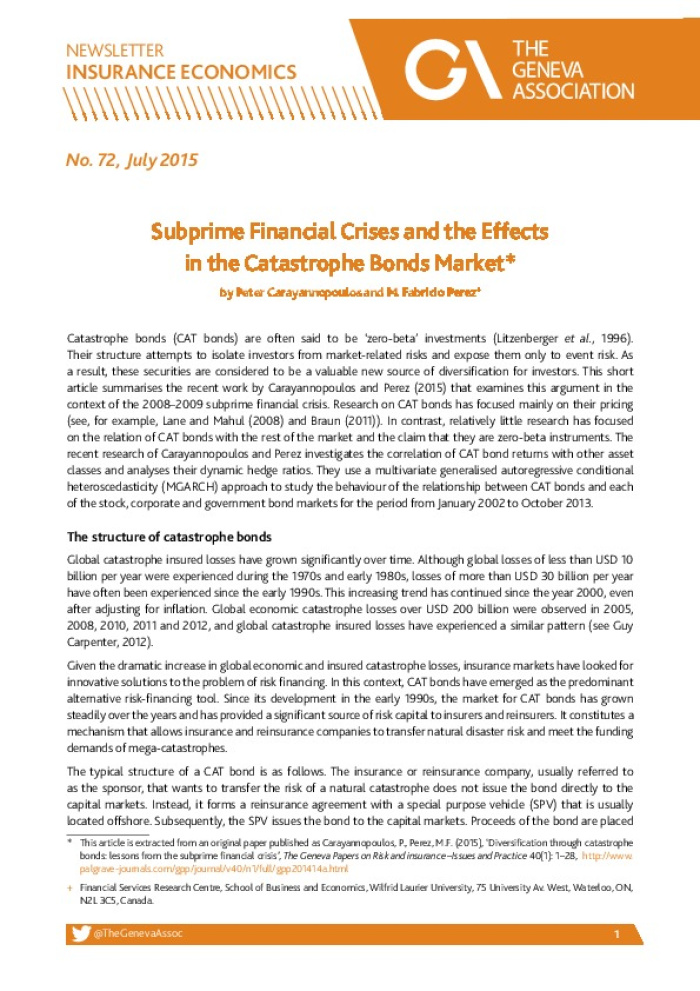Subprime Financial Crises and the Effects in the Catastrophe Bonds Market
Article from Insurance Economics Newsletter No. 72

1 FINANCIAL SBILITY AT ION NEWSLETTER INSURANCE ECONOMICS Subprime Financial Crises and the Effects in the Catastrophe Bonds Market* by Peter Carayannopoulos and M. Fabricio Perez+ Catastrophe bonds (CAT bonds) are often said to be ?zero-beta? investments (Litzenberger et al., 1996). Their structure attempts to isolate investors from market-related risks and expose them only to event risk. As a result, these securities are considered to be a valuable new source of diversification for investors. This short article summarises the recent work by Carayannopoulos and Perez (2015) that examines this argument in the context of the 2008?2009 subprime financial crisis. Research on CAT bonds has focused mainly on their pricing (see, for example, Lane and Mahul (2008) and Braun (2011)). In contrast, relatively little research has focused on the relation of CAT bonds with the rest of the market and the claim that they are zero-beta instruments. The recent research of Carayannopoulos and Perez investigates the correlation of CAT bond returns with other asset classes and analyses their dynamic hedge ratios. They use a multivariate generalised autoregressive conditional heteroscedasticity (MGARCH) approach to study the behaviour of the relationship between CAT bonds and each of the stock, corporate and government bond markets for the period from January 2002 to October 2013. The structure of catastrophe bonds Global catastrophe insured losses have grown significantly over time. Although global losses of less than USD 10 billion per year were experienced during the 1970s and early 1980s, losses of more than USD 30 billion per year have often been experienced since the early 1990s. This increasing trend has continued since the year 2000, even after adjusting for inflation. Global economic catastrophe losses over USD 200 billion were observed in 2005, 2008, 2010, 2011 and 2012, and global catastrophe insured losses have experienced a similar pattern (see Guy Carpenter, 2012). Given the dramatic increase in global economic and insured catastrophe losses, insurance markets have looked for innovative solutions to the problem of risk financing. In this context, CAT bonds have emerged as the predominant alternative risk-financing tool. Since its development in the early 1990s, the market for CAT bonds has grown steadily over the years and has provided a significant source of risk capital to insurers and reinsurers. It constitutes a mechanism that allows insurance and reinsurance companies to transfer natural disaster risk and meet the funding demands of mega-catastrophes. The typical structure of a CAT bond is as follows. The insurance or reinsurance company, usually referred to as the sponsor, that wants to transfer the risk of a natural catastrophe does not issue the bond directly to the capital markets. Instead, it forms a reinsurance agreement with a special purpose vehicle (SPV) that is usually located offshore. Subsequently, the SPV issues the bond to the capital markets. Proceeds of the bond are placed No. 72, July 2015 * This article is extracted from an original paper published as Carayannopoulos, P., Perez, M.F. (2015), ?Diversification through catastrophe bonds: lessons from the subprime financial crisis?, The Geneva Papers on Risk and insurance ?Issues and Practice 40(1): 1?28, http://www. palgrave-journals.com/gpp/journal/v40/n1/full/gpp201414a.html + Financial Services Research Centre, School of Business and Economics, Wilfrid Laurier University, 75 University Av. West, Waterloo, ON, N2L 3C5, Canada. @TheGenevaAssoc INSURANCE ECONOMICS